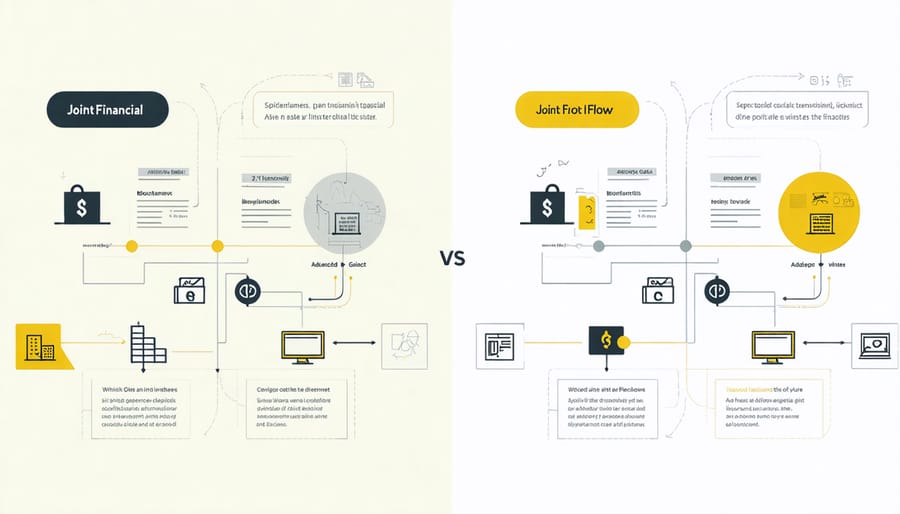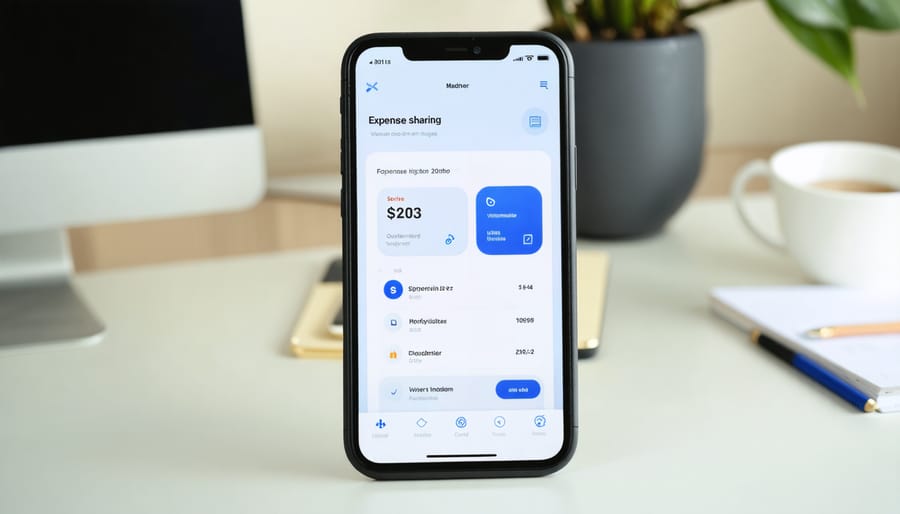
Merging finances with your partner marks a significant milestone in your relationship – one that requires careful planning, open communication, and mutual trust. While financial challenges in relationships are common, combining your money doesn’t have to create tension or conflict. Whether you’re newly married, moving in together, or simply ready to take your commitment to the next level, choosing the right strategy to merge your finances can strengthen both your financial future and your partnership.
Think of combining finances as building a shared foundation for your dreams – from planning vacations to buying a home or starting a family. The key lies in finding an approach that honors both partners’ financial habits, goals, and comfort levels while creating a system that works seamlessly in your daily lives.
In this guide, we’ll explore six proven methods for combining finances with your partner, each offering different levels of financial integration. From partial pooling to complete merging, these strategies can be customized to fit your unique relationship dynamics and financial objectives. The best part? You can start implementing these approaches today, making small adjustments as you discover what works best for your partnership.
The Partial Pool Method
Setting Up Your Shared Account
Ready to set up your shared account? I remember how excited (and slightly nervous) my partner and I were when we took this step! Here’s your easy-to-follow guide to getting started.
First, schedule a money date with your partner to discuss your shared expenses and decide how much each of you will contribute. Many couples find the 50/50 split works well, but you can adjust based on your individual incomes and circumstances.
Next, research joint account options at your preferred bank. Look for accounts with no monthly fees and convenient features like mobile banking. Once you’ve chosen, gather your IDs, proof of address, and any other required documents.
Visit the bank together to open the account. You’ll both need to be present to sign the paperwork. Set up direct deposits from your individual accounts for your agreed-upon contributions, and create a list of bills to be paid from this account.
Pro tip: Start with a smaller shared pot for household expenses before combining all your finances. This gives you time to adjust to managing money together while maintaining some financial independence.
Remember to regularly review and adjust your contributions as your circumstances change. Open communication is key to making your shared account work smoothly!
Calculating Fair Contributions
When it comes to shared expenses, fair doesn’t always mean equal. The key is finding a balance that feels right for both partners, especially when there’s an income gap. One popular approach is the proportional method, where each partner contributes based on their percentage of the total household income. For example, if you earn 60% of the combined income, you’d cover 60% of the shared expenses.
Another thoughtful way to divide costs is the “essential vs. extras” approach. Both partners contribute equally to basic necessities like rent and utilities, while discretionary expenses are split based on individual incomes or preferences. This can help prevent resentment while maintaining financial harmony.
Remember to have open conversations about what feels fair to both of you. Some couples find success with a hybrid system – perhaps splitting fixed expenses proportionally while maintaining separate accounts for personal spending. Whatever method you choose, review it periodically to ensure it still works as your financial situation evolves.
Pro tip: Create a shared spreadsheet to track expenses and calculate contributions. This transparency helps avoid misunderstandings and keeps both partners accountable to their agreed-upon financial commitments.
The Complete Merger Approach

Creating Financial Transparency
Creating a foundation of financial transparency starts with maintaining open communication about money matters. Consider setting up regular “money dates” – casual, judgment-free conversations where you discuss your financial goals, concerns, and spending habits. Using shared budgeting apps like Mint or YNAB can make tracking expenses together easier and more transparent.
Create a shared spreadsheet or digital document where you both log major purchases and financial decisions. This doesn’t mean you need to report every coffee run, but staying honest about significant expenses helps build trust and understanding. Consider setting a threshold amount – say, $100 or more – that requires a heads-up to your partner before spending.
Many couples find success using a shared digital calendar to mark bill due dates and regular financial check-ins. This keeps both partners informed and accountable. Remember to celebrate financial wins together, whether it’s paying off a debt or reaching a savings milestone. These positive reinforcements make the journey of financial transparency more enjoyable and strengthen your partnership.
Setting Joint Financial Goals
Setting joint financial goals is like creating a shared vision board for your future together. Start by scheduling a “money date” where you can both openly discuss your dreams and aspirations. Whether it’s saving for a dream home, planning that European vacation, or building your retirement nest egg, balancing personal and shared goals is key to financial harmony.
Create a list of short-term and long-term objectives, and prioritize them together. For example, you might agree to save $30,000 for a house down payment within two years while simultaneously building individual emergency funds. Be specific about numbers and timelines – this clarity helps prevent misunderstandings later.
Consider using a shared spreadsheet or budgeting app to track your progress. Set monthly check-ins to celebrate wins and adjust strategies if needed. Remember, financial goals aren’t just about numbers; they’re about building the life you want together. Make sure both partners’ dreams are represented in your shared financial roadmap, and be willing to compromise when priorities differ.
The Proportional System

Calculating Your Ratio
When it comes to managing income differences, finding the right ratio for expense sharing can feel like solving a puzzle. A popular approach is the proportional method, where each partner contributes based on their income percentage. For example, if you earn $60,000 and your partner makes $40,000, you might split expenses 60/40 rather than 50/50.
To calculate your ratio, add your combined income and determine each person’s percentage. Let’s say your total household income is $100,000 – divide each individual income by this number to get your percentages. You can then apply this same ratio to your shared expenses, from rent to utilities.
Remember, these calculations are just a starting point. Some couples prefer to adjust their ratios to account for other factors, like one partner’s student loans or family obligations. The key is finding a balance that feels fair and comfortable for both of you. Consider reviewing and adjusting your ratio annually or whenever there’s a significant change in either partner’s income to ensure it continues to work for your relationship.
Managing Variable Expenses
Variable expenses can be one of the trickiest parts of managing shared finances, but I’ve found that treating them like a team sport makes all the difference. Start by creating a shared “flex fund” – think of it as your relationship’s financial safety net. My partner and I learned this the hard way when our water heater decided to quit during the coldest week of winter!
Set aside a percentage of both incomes each month specifically for these unpredictable costs. A good starting point is 10% of your combined take-home pay, but adjust based on your lifestyle and spending patterns. Keep this money in a separate savings account that you both can access.
Use a shared expense tracking app to monitor variable costs like groceries, dining out, and entertainment. This transparency helps prevent surprises and makes it easier to spot spending patterns. When unexpected expenses pop up, discuss them together and decide how to handle them from your flex fund.
Remember to review and adjust your variable expense strategy quarterly. As your life circumstances change, so will your spending needs. Keep the communication flowing and be flexible with your approach – what works now might need tweaking later.
The Hybrid Method
Creating Your Custom Mix
Creating your perfect financial blend is like crafting a custom recipe – it should reflect your unique relationship dynamics and lifestyle needs. While there are many common relationship misconceptions about money management, the truth is that no single approach works for everyone.
Start by having an open conversation with your partner about your individual money habits, values, and goals. Consider which aspects of the previous methods resonate with you both and which elements make you uncomfortable. Maybe you love the idea of maintaining some financial independence but want the security of joint accounts for shared expenses. Or perhaps you prefer pooling everything but want to keep personal allowances for discretionary spending.
Think about creating a hybrid system that might include:
– A joint account for household expenses and shared goals
– Individual accounts for personal spending
– Separate investment accounts while maintaining shared retirement planning
– A combination of joint and separate credit cards
– Shared access to certain accounts while maintaining privacy for others
Remember to build flexibility into your system. Your financial needs will evolve as your relationship grows, so establish regular check-ins to assess and adjust your approach. Consider starting with a trial period to test your chosen method before making long-term commitments.
The key is finding a balance that honors both partners’ financial autonomy while building a strong foundation for your shared future. Don’t be afraid to tweak and adjust until you find what works best for your unique situation.
The Bill-Splitting Strategy
Using Technology to Track Expenses
Gone are the days of splitting bills with paper receipts and endless calculations! Today’s tech-savvy couples have a wealth of digital tools at their fingertips to make expense tracking a breeze. I remember when my partner and I first started using a shared expense app – it was like a weight lifted off our shoulders, and those awkward “who paid for what” conversations became a thing of the past.
Popular apps like Splitwise, Honeydue, and Mint have revolutionized how couples manage their shared finances. Splitwise, for instance, is perfect for couples who maintain separate accounts but share expenses. It keeps a running tab of who owes what, making it easy to settle up at the end of the month. Honeydue takes things a step further by allowing couples to link their bank accounts, set bill reminders, and chat about expenses right in the app.
For couples who prefer a more comprehensive approach, apps like YNAB (You Need A Budget) or Personal Capital offer robust budgeting features alongside expense tracking. These tools provide detailed insights into your spending patterns and help you work toward shared financial goals.
My personal favorite feature of these apps is their ability to automatically categorize expenses, which makes it super simple to see where your money is going as a couple. Plus, many of these apps send real-time notifications when bills are due or when spending in certain categories gets close to your preset limits.
Remember, the key is finding an app that matches your couple’s specific needs and comfort level with technology. Start with one that feels intuitive to both of you, and don’t be afraid to try different options until you find your perfect match.

The Investment Partnership
Building Wealth Together
Building wealth as a couple isn’t just about combining bank accounts – it’s about creating a shared vision for your financial future. Start by having an open conversation about your investment goals. Maybe you’re dreaming of buying a home together, starting a family, or retiring early. Whatever your aspirations, getting on the same page early makes the journey smoother.
Consider setting up regular “money dates” where you review your investments together. During these check-ins, discuss everything from retirement contributions to potential investment opportunities. It’s perfectly fine if one partner is more financially savvy – use this as an opportunity to learn from each other and grow together.
Create a joint investment strategy that reflects both partners’ risk tolerance. If you’re more conservative while your partner loves high-risk investments, find a middle ground. You might allocate a portion of your portfolio to safer investments while keeping some funds for more aggressive growth opportunities.
Don’t forget to maximize your employer benefits as a couple. Review each other’s 401(k) plans, matching contributions, and health savings accounts. Sometimes, one partner’s workplace benefits might be better, so you can strategically decide where to focus your investments.
Think about opening a joint investment account alongside your individual retirement accounts. This can be your “couple’s fund” for shared goals like that dream vacation home or starting a business together. Many couples find success with the “yours, mine, and ours” approach to investing, maintaining some individual autonomy while building wealth together.
Remember, building wealth isn’t a race – it’s a marathon you’re running together. Celebrate small wins and adjust your strategy as your life circumstances change.
Remember, there’s no one-size-fits-all approach when it comes to managing money with your partner. The key is finding a system that aligns with both your values and relationship dynamics. Whether you choose to fully merge your finances, maintain separate accounts with a joint fund, or opt for a proportional contribution method, what matters most is open communication and mutual understanding.
Take time to discuss these options with your partner, and don’t be afraid to adjust your approach as your relationship evolves. Some couples find success by starting with one method and gradually transitioning to another as their financial situation changes. The most successful couples regularly review and refine their financial strategy together.
Whatever method you choose, keep those money conversations flowing and stay flexible. Your financial partnership, like your relationship, is a journey that grows and changes over time.



